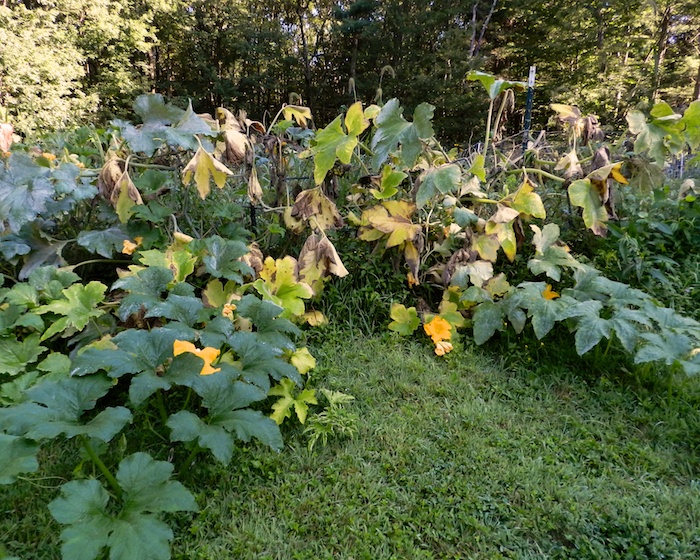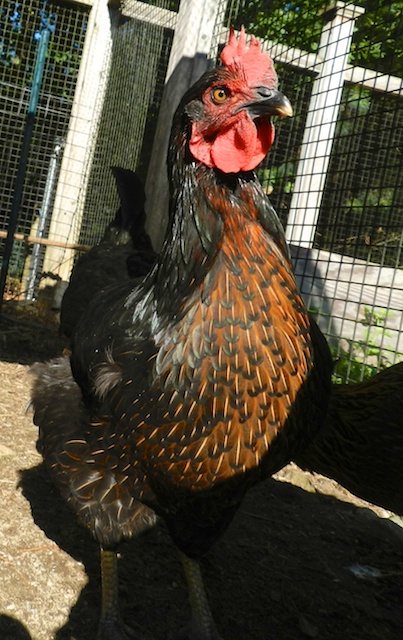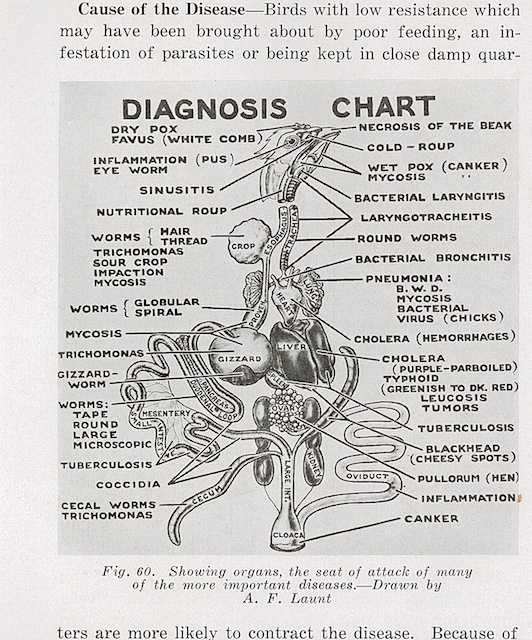T-shirts and other items now available!
Monthly Archives: August 2013
The Late Summer Garden
As much as I love the beauty of delicate spring flowers, there’s something about the robust and deeply-hued blooms of fall that makes my heart happy. It’s a bittersweet view in my backyard, as I know what’s around the corner, but for now it feels like a celebration out there.
The tallest varieties of sunflowers have reached their astounding height and are in full-faced bloom.
Bees add to the vibrancy of the picture.
Years ago, I planted Joe Pye weed in the meadow, not only for it’s color, but because it’s an important late summer food for butterflies and bees. It’s humming out there.
Goldenrod, too, supports native creatures. It self-seeded in the meadow. The goats are pleased, because when the heads die off, I cut it down and feed it to them. They like it more than hay.
In the vegetable garden, some plants, like peas, are long past harvest, but the tomatoes are ripening.
The basil has done really well this year. I’ve already frozen a bagful, and it keeps on forming tender, and not at all bitter, leaves.
After a hard pruning this past winter, and some attempts at pest control, the peaches are looking really good. But, whether I get them before the worms and the chipmunks is yet to be seen.
At this time of year, mildew wilts the leaves in the pumpkin patch,
but it won’t do much damage, as the vegetables are already formed and hardening off.
Anyway, I’ve grown way too much winter squash for my family to eat. Most are slated to be fed to the chickens this winter. They’re going to be happy and busy girls.
Meet Nancy Drew
I have six chickens, all of which hatched on March 29 at the Murray McMurray facility, and arrived here two days later. I’ve named them after favorite authors and book characters, and so I call them The Literary Ladies. I’ve introduced the other pullets to you in other blogposts; today is Nancy Drew’s turn.
Nancy Drew is a Black Star, which is a hybrid known as a sex-link, because at the time of hatch you can tell the boys from the girls by the color of their down. This means that you won’t get an unwanted roo in your order. Being a hybrid, the Black Star is a prolific layer. I had a Black Star a few years ago. Her name was Ginger and she was outgoing, friendly, curious and an all-around nice hen. Nancy Drew is a worthy successor.
I think that Black Stars are pretty birds, what with their glossy black back feathers and red bibs. They have upright combs and perfectly shaped wattles. Classic chickens!
Based on Ginger’s personality, I thought that Nancy Drew would be an appropriate name for a Black Star, and I was right. Nancy Drew is the first to investigate the rivets on my pants.
Doesn’t this face have the look of a detective?
Nancy Drew will be 20 weeks old this week. She’ll be laying brown eggs soon.
Warhol Goats
While we were away the GoatCam finally gave up the ghost and died. Over the few days that its circuits went bonkers, the GoatCam got artistic. For awhile a gallery of Warhol Goats were streamed online.
IT Guy Steve spent yesterday morning replacing the cam. I assisted by getting the goats into the pasture and closing the gate behind them. They do like *helping* with tools, but for some reason Steve thought he could do a better job without them supervising.
So, the GoatCam is now back up and running, albeit a bit less colorfully than last week. We’ll be purchasing new cams, like the spiffy HenCam model, in the next few months. Your support via the coffee button, and through my store, helps us to keep the livestreaming cams in the realistic school of art and not in pop art. Thanks!
Update: due to popular demand, T-shirts and gifts with this image are now available from The HenCam Store!
Chicken Necropsies
Over the years I’ve seen many sick chickens. You can divide the ailments into respiratory and other. Respiratory disease can spread quickly through your flock. It can be lethal. You’ll find a lot of erroneous information online about how to determine which pathogen has caused the outbreak; there is no way of telling without expensive lab tests. I know, because I’ve gone that route. Unless you are a professional farmer, it doesn’t make much difference to know what germs are causing your hens to wheeze and go listless. The treatment is the same. Antibiotics can often stem the tide, as I detailed here.
That other category covers everything from cancer, to fatty liver disease, to internal laying. Once again, it’s sheer guesswork to try to deduce the underlying cause of your hen’s symptoms. Once again, almost everything you read online is wrong. A chicken has only so many ways of looking ill, and that penguin stance, the listlessness, the dark comb, can be caused by any number of very different ailments.
Sometimes those symptoms don’t point to a lethal disease. Sometimes a chicken simply needs to get their internal systems moving. Maybe her mineral balance is out of whack. Maybe an egg is taking too long to move along the repro tract. Maybe her digestion has stalled. In those cases, my Spa Treatment will put things to right. You’ll still only be guessing about the root cause, but at least your hen will get some relief. If the Spa Treatment doesn’t work, and your chicken dies, it’s still all guesswork as to the cause unless you do a necropsy.
Some states allow you to send a dead chicken to their labs to be examined, but this service is meant for professional farmers. If everyone with backyard chickens sent their deceased birds in, it would bankrupt the programs. In any event, my state doesn’t offer this option. My own vet doesn’t do necropsies, either. In the past, if I wanted to know why a chicken died, I’d have to pay to ship it out of state. It was prohibitively expensive. I was frustrated with not knowing what my chickens died of. Fortunately, in January of 2010, I was able to attend a necropsy workshop at a poultry show, where I learned how to do this procedure myself. Because it wasn’t prudent to bring diseased birds onto the premises, we practiced on healthy cockerels. So, the workshop taught me the basics, but after doing my first necropsy on a hen from my own flock, it was obvious that a healthy rooster is nothing like an aged laying hen.
I looked for necropsy tutorials. Cornell Veterinary School has put a 4-hour video online. I watched that. State extension services have basic information online, like this fact sheet from Ohio State. I found papers about specific diseases, like this one on kidney damage in commercial layers. I looked through my collection of poultry books. The most useful illustrations were found in the older books, when farmers had small flocks and did the necropsies themselves.
All of this research was helpful, but what I found inside of my old chickens didn’t match the tidy illustrations from the manuals. I contacted a vet in Michigan who does necropsies with the 4-H club kids. I contacted an avian vet in England who is experienced with older backyard birds. I’ve been learning a lot. I’ve done thirteen necropsies. Each time I learn something new. Each time, before I do the necropsy, I think that I have a good sense of what was wrong with the hen. Each time I was wrong. Two chickens, the same age, breed and care, died within a month of each other. They both exhibited the same symptoms. But, what I found inside was not at all the same.
What I can tell you is that by the time a chicken dies, her internal organs are a mess. I’ve seen ovarian cancer, tumors and blocked guts. I’ve seen masses of solidified eggs in the body cavity, infected fluid, and a heart that looked like jelly. It is astounding what a diseased chicken can live with before she shows signs of illness. I’ve come to believe that by the time I see her standing hunched and miserable, that things have been going wrong inside of her for a long time. This is why, if a hen is not eating on her own, that I don’t feed her with a syringe, or baby her with gruel. Or, If she has fluid in the body cavity, I know that there’s an underlying disease causing it and I’m not going to drain her and keep her around for a few more months. I’ve come to know that when a hen can’t eat, that she is suffering. If she is listless in a corner, then she is suffering. I’ve come to believe in the kindness of euthanizing.
Doing the necropsies has taught me more than I’d ever hope to learn from a book or a video. Doing them has certainly taught me that most of the amateur diagnoses out there (for example, “she’s egg bound”) are just plain wrong. This doesn’t mean that you, too, have to do necropsies. Knowing the cause doesn’t change the outcome. (The only exceptions are the increasing number of hens dying of fatty liver disease because of overfeeding scratch corn, and the hens dying of kidney disease due to overfeeding of meal worms. Read about feeding here.) However, the knowledge that I gain from the necropsies makes me a better chicken keeper. Telling you about what I find in the necropsies helps everyone.
If you do home necropsies, have taken a necropsy workshop, or found a good source of information, let me know. There’s much more to learn.














